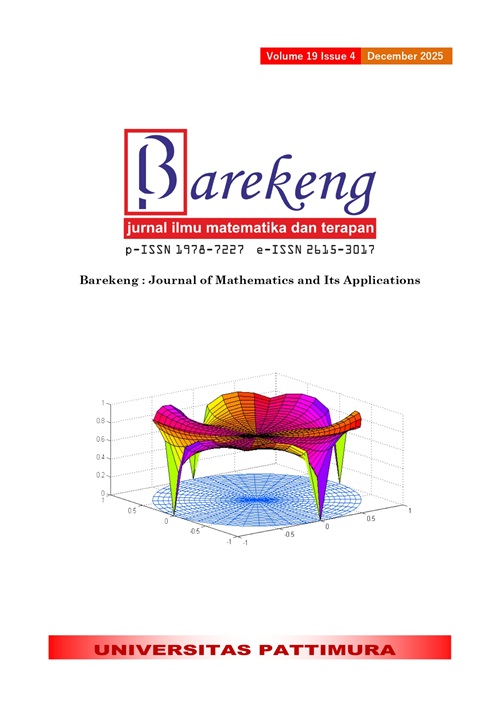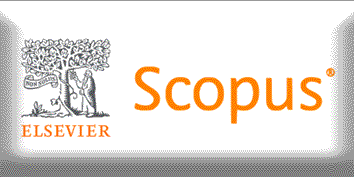THE UTILIZATION OF TRANSITION MATRIX IN BONUS-MALUS SCHEME FOR DETERMINING MOTOR VEHICLE INSURANCE PREMIUMS
Abstract
Motor vehicle usage in Indonesia ranks among the highest globally, reaching approximately 141,992,573 units. The growing variety and number of automobiles contribute significantly to traffic congestion and heightened risks to public safety. Given the inherent dangers associated with motorized transportation, including auto theft and accidents, efforts to shift these risks to insurance companies have become crucial. The fundamental idea of insurance is to establish a pool in which policyholders can manage their risk, with premiums determined by the amount of risk that each participant adds to the group. Actuaries in the field of motor vehicle insurance must generate a reasonable premium rate utilizing a variety of methodologies, including the Bonus-Malus approach. The latter, a widely utilized approach, classifies policyholders based on their claims history, incentivizing safe driving. Examining the internal dynamics of the Bonus-Malus system necessitates studying mathematics, particularly algebra, and the use of linear algebra in transition matrices is critical in anticipating changes in bonus-malus rates over time. This research is a quantitative descriptive analysis that explores the implementation of the Bonus-Malus system using a transition matrix framework. It aims to investigate the collaboration of algebra and actuarial science in a real-world application of the Bonus-Malus scheme for motor vehicle insurance, focusing on the use of the transition matrix in premium computation, utilizing secondary data from PT. Jasa Raharja Kota Semarang for the years 2021–2022. The transition matrix analysis shows that Model 2 allows for smoother class transition, lowers the possibility of high-risk class recurrence, and provides more consistent premium adjustments. This demonstrates the model's ability to create a balanced incentive structure while interpreting claim trends. Furthermore, Model 2 has a greater expected value of Loimaranta efficiency than Model 1, supporting findings that added status improves Bonus-Malus system efficiency.
Downloads
References
J. Azhar and S. Nugraha, “ANALYSIS OF FACTORS AFFECTING PUBLIC INTEREST TO REGISTER FOR A MOTOR VEHICLE INSURANCE PROGRAM,” Journal of Islamic Business and Economic Review, vol. 4, no. 2, pp. 66–73, 2021.
P. Baruah and P. P. Singh, “RISK PREDICTION IN LIFE INSURANCE INDUSTRY USING MACHINE LEARNING TECHNIQUES—A REVIEW,” in International Conference on Advances in IoT and Security with AI, Springer, 2023, pp. 323–332.doi: https://doi.org/10.1007/978-981-99-5085-0_31
P. Hosein, “A DATA SCIENCE APPROACH TO RISK ASSESSMENT FOR AUTOMOBILE INSURANCE POLICIES,” Int J Data Sci Anal, vol. 17, no. 1, pp. 127–138, 2024.doi: https://doi.org/10.1007/s41060-023-00392-x
M. Wiedemann and D. John, “A Practitioners Approach To Individual Claims Models For Bodily Injury Claims In German Non-Life Insurance,” Zeitschrift für die gesamte Versicherungswissenschaft, vol. 110, no. 4, pp. 225–254, 2021.doi: https://doi.org/10.1007/s12297-021-00511-2
E. Lesmana, R. Wulandari, H. Napitupulu, and S. Supian, “MODEL ESTIMATION OF CLAIM RISK AND PREMIUM FOR MOTOR VEHICLE INSURANCE BY USING BAYESIAN METHOD,” in IOP Conference Series: Materials Science and Engineering, IOP Publishing, 2018, p. 012027.doi: https://doi.org/10.1088/1757-899X/300/1/012027
T. Rahmawati, D. Susanti, and R. Riaman, “DETERMINING PURE PREMIUM OF MOTOR VEHICLE INSURANCE WITH GENERALIZED LINEAR MODELS (GLM),” International Journal of Quantitative Research and Modeling, vol. 4, no. 4, pp. 207–214, 2023.doi: https://doi.org/10.46336/ijqrm.v4i4.492
A. Moumeesri and T. Pongsart, “BONUS-MALUS PREMIUMS BASED ON CLAIM FREQUENCY AND THE SIZE OF CLAIMS,” Risks, vol. 10, no. 9, p. 181, 2022.doi: https://doi.org/10.3390/risks10090181
A. Awatif, I. G. P. PURNABA, and I. W. MANGKU, “SIMULASI SISTEM BONUS-MALUS PADA ASURANSI KENDARAAN BERMOTOR BERDASARKAN JENIS KECELAKAAN DAN TINGKAT KEPARAHAN,” MILANG Journal of Mathematics and Its Applications, vol. 17, no. 1, pp. 17–32, 2018. Doi: https://doi.org/10.29244/jmap.17.1.17-32
A. S. Pratama, S. Nurrohmah, and M. Novita, “DETERMINATION OF NET PREMIUM RATES ON BONUS-MALUS SYSTEM BASED ON FREQUENCY AND SEVERITY DISTRIBUTION,” in Journal of Physics: Conference Series, D. Triyono, A. Sulaswaty, and I. T. Anggraningrum, Eds., Institute of Physics Publishing, 2020. doi: https://doi.org/10.1088/1742-6596/1442/1/012034.
U. Mukhaiyar, U. S. Pasaribu, R. Yuliawan, and B. N. Permana, “A BAYESIAN APPROACH TO THE CLASSIC AND OPTIMAL BONUS-MALUS SYSTEMS IN PURE PREMIUM CALCULATIONS OF VEHICLE INSURANCE,” in AIP Conference Proceedings, Y. Susanti, N. Susyanto, Z. Purisha, M. Tantrawan, and I. Ernanto, Eds., American Institute of Physics, 2024. doi: https://doi.org/10.1063/5.0230649.
E. Gómez-Déniz, “BIVARIATE CREDIBILITY BONUS–MALUS PREMIUMS DISTINGUISHING BETWEEN TWO TYPES OF CLAIMS,” Insur Math Econ, vol. 70, pp. 117–124, 2016.doi: https://doi.org/10.1016/j.insmatheco.2016.06.009
T. Pongsart, A. Moumeesri, T. Mayureesawan, and W. Phaphan, “COMPUTING BAYESIAN BONUS-MALUS PREMIUM DISTINGUISHING AMONG DIFFERENT MULTIPLE TYPES OF CLAIMS,” Lobachevskii Journal of Mathematics, vol. 42, no. 13, pp. 3208–3217, 2021, doi: https://doi.org/10.1134/S1995080222010164.
S. Liu, B. Zheng, G. Li, P. Shen, and J. Liu, “OPTIMIZATION OF BMS IN MOTOR VEHICLE INSURANCE,” in Proceedings - 2016 International Conference on Smart Grid and Electrical Automation, ICSGEA 2016, Institute of Electrical and Electronics Engineers Inc., 2016, pp. 136–138. doi: https://doi.org/10.1109/ICSGEA.2016.17.
I. V SUKHORUKOVA and N. A. cHISTYAKOVA, “METHODICAL ASPECTS OF ACTUARIAL MATHEMATICS TEACHING.,” Astra salvensis, 2018.
R. Oh, N. Woo, J. K. Yoo, and J. Y. Ahn, “PREDICTIVE ANALYSIS IN INSURANCE: AN APPLICATION OF GENERALIZED LINEAR MIXED MODELS,” Commun Stat Appl Methods, vol. 30, no. 5, pp. 437–451, 2023.doi: https://doi.org/10.29220/CSAM.2023.30.5.437
P. Embrechts and M. V Wüthrich, “RECENT CHALLENGES IN ACTUARIAL SCIENCE,” Annu Rev Stat Appl, vol. 9, no. 1, pp. 119–140, 2022.doi: https://doi.org/10.1146/annurev-statistics-040120-030244
L. Day, D. Siemon, R. Callingham, and R. Seah, “CONNECTING THE THREADS: THE ROLE OF MULTIPLICATIVE THINKING IN ALGEBRAIC, GEOMETRICAL, AND STATISTICAL REASONING,” Research in Mathematics Education, vol. 26, no. 2, pp. 325–347, 2024.doi: https://doi.org/10.1080/14794802.2024.2372365
W. Freeden, C. Heine, and M. Z. Nashed, “RECENT ACTIVITIES IN GEOMATHEMATICS,” in Lecture Notes in Geosystems Mathematics and Computing, Springer Nature, 2019, pp. 91–92. doi: https://doi.org/10.1007/978-3-030-13054-1_4.
L. V Shelekhova, “THE INTERDISCIPLINARY INTEGRATION OF THE MATHEMATICAL AND ECONOMIC DISCIPLINES WITHIN THE MODERN ECONOMIC EDUCATION,” Mediterr J Soc Sci, vol. 6, no. 5S1, pp. 122–127, 2015, doi: 10.5901/mjss.2015.v6n5s1p122.
R. Wess, H. Klock, H.-S. Siller, and G. Greefrath, “MATHEMATICAL MODELLING,” in International Perspectives on the Teaching and Learning of Mathematical Modelling, Springer Science and Business Media B.V., 2021, pp. 3–20. doi: https://doi.org/10.1007/978-3-030-78071-5_1.
D. N. Santi, I. G. P. Purnaba, and I. W. Mangku, “BONUS-MALUS SYSTEM WITH THE CLAIM FREQUENCY DISTRIBUTION IS GEOMETRIC AND THE SEVERITY DISTRIBUTION IS TRUNCATED WEIBULL,” in IOP Conference Series: Earth and Environmental Science, H. Hardhienata and H. Alatas, Eds., Institute of Physics Publishing, 2016. doi: https://doi.org/10.1088/1755-1315/31/1/012006.
M. Gyetvai and K. C. Ágoston, “OPTIMIZATION OF TRANSITION RULES IN A BONUS-MALUS SYSTEM,” Electron Notes Discrete Math, vol. 69, pp. 5–12, 2018, doi: https://doi.org/10.1016/j.endm.2018.07.002.
C. I. Tan, “VARYING TRANSITION RULES IN BONUS-MALUS SYSTEMS: FROM RULES SPECIFICATION TO DETERMINATION OF OPTIMAL RELATIVITIES,” Insur Math Econ, vol. 68, pp. 134–140, 2016, doi: https://doi.org/10.1016/j.insmatheco.2016.03.007.
Z. K. Kamal, “BONUS MALUS SYSTEM IN AUTOMOBILE INSURANCE”.
K. Fackeldey, A. Niknejad, and M. Weber, “FINDING METASTABILITIES IN REVERSIBLE MARKOV CHAINS BASED ON INCOMPLETE SAMPLING,” Special Matrices, vol. 5, no. 1, pp. 73–81, 2017, doi: https://doi.org/10.1515/spma-2017-0006.
M. S. Sinaga, O. Purba, and H. Nasution, “FINITE MARKOV CHAIN IN INVENTORY CONTROL,” in Journal of Physics: Conference Series, M. Restuati, H. Sipahutar, and J. Rajagukguk, Eds., Institute of Physics Publishing, 2020. doi: https://doi.org/10.1088/1742-6596/1462/1/012039.
K. C. Ágoston and M. Gyetvai, “JOINT OPTIMIZATION OF TRANSITION RULES AND THE PREMIUM SCALE IN A BONUS-MALUS SYSTEM,” ASTIN Bulletin, vol. 50, no. 3, pp. 743–776, 2020, doi: https://doi.org/10.1017/asb.2020.27.
K. P. Das, “A STOCHASTIC APPROACH TO THE BONUS-MALUS SYSTEM,” Neural, Parallel and Scientific Computations, vol. 18, no. 3–4, pp. 283–290, 2010, [Online]. Available: https://www.scopus.com/inward/record.uri?eid=2-s2.0-79551596250&partnerID=40&md5=d50d5bc523510e0a20e25004841446eb
R. Loeffen, “LECTURE NOTES ON: ACTUARIAL MODELS,” 2014, The University of Manchester.
A. K. Basu, INTRODUCTION TO STOCHASTIC PROCESS. Alpha Science Int’l Ltd., 2003.
Y. Chen and L. Li, “ANALYSIS OF RELATIVITY PREMIUM IN BONUS-MALUS SYSTEM BASED ON OPTIMAL LINEAR METHOD,” Math Probl Eng, vol. 2014, 2014, doi: https://doi.org/10.1155/2014/846407.
A. T. Payandeh Najafabadi and M. Sakizadeh, “DESIGNING AN OPTIMAL BONUS-MALUS SYSTEM USING THE NUMBER OF REPORTED CLAIMS, STEADY-STATE DISTRIBUTION, AND MIXTURE CLAIM SIZE DISTRIBUTION,” International Journal of Industrial and Systems Engineering, vol. 32, no. 3, pp. 304–331, 2019, doi: https://doi.org/10.1504/IJISE.2019.101117.
S. A. Klugman, H. H. Panjer, and G. E. Willmot, LOSS MODELS: FROM DATA TO DECISIONS, vol. 715. John Wiley & Sons, 2012.
M. V Wüthrich and M. Merz, STOCHASTIC CLAIMS RESERVING METHODS IN INSURANCE. John Wiley & Sons, 2008.
Copyright (c) 2025 Seftina Diyah Miasary, Ayus Riana Isnawati, Hana Zhafira Marmu'asyifa

This work is licensed under a Creative Commons Attribution-ShareAlike 4.0 International License.
Authors who publish with this Journal agree to the following terms:
- Author retain copyright and grant the journal right of first publication with the work simultaneously licensed under a creative commons attribution license that allow others to share the work within an acknowledgement of the work’s authorship and initial publication of this journal.
- Authors are able to enter into separate, additional contractual arrangement for the non-exclusive distribution of the journal’s published version of the work (e.g. acknowledgement of its initial publication in this journal).
- Authors are permitted and encouraged to post their work online (e.g. in institutional repositories or on their websites) prior to and during the submission process, as it can lead to productive exchanges, as well as earlier and greater citation of published works.






1.gif)



